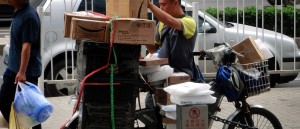Few nations are as dependent on logistics as China. As the workshop of the modern world and with by far its largest population, it has to move, store and handle a bewildering amount of stuff. According to my calculations, based on Chinese government data, the country’s transport system moves around 32 tonnes of freight per person per annum. Multiply that figure by the 1.38 billion people who live in China and you get a sense of the country’s logistical challenge. It generates around 25 times more freight movement per $ of GDP than the UK, reflecting both its much greater size and very different economic structure. Given this high level of freight transport intensity, it is hardly surprising that logistics expenditure accounts for around 16% of China’s GDP, roughly twice the equivalent US figure.
On a recent visit to China I gave a speech on logistics skills at a conference organised by the Chinese Federation of Logistics and Purchasing in Nanjing. The CFLP had just published its annual report on logistics education in China. This indicates that in 2015 a total of 979 logistics courses were offered by 785 universities and colleges across the country. A total of 85,438 students were enrolled on these courses! The vocational and higher education systems have clearly geared up to supply the vast number of qualified managers that will be required to run China’s bourgeoning logistics system.
Capacity building in logistics education is paralleled by the growth of Chinese research on supply chain management. In a newly published paper, Prof Xiaohong Liu and I examine the theoretical foundations of this research in a review of 150 articles on Chinese supply chains published in sixteen journals between 2000 and 2014. This revealed a heavy reliance on Western business theories and limited evidence of China-based researchers ‘attempting to customise them to the Chinese context or to construct new ones’.
This is a pity as there are distinct features of Chinese business practice, most notably Guanxi (networks of personal relationship and social influence), which differentiate the management of Chinese supply chains from that of Western countries. Guanxi may be conducive to the adoption of new models of collaboration in the logistics sector which will be needed to achieve a step-change in asset utilisation. It has been estimated that 40% of truck-kms in China are run empty, creating a big opportunity to cut the amount of truck traffic generated by the 6 trillion tonne-kms of freight movement on Chinese roads each year. Given the huge scale of Chinese logistics, seizing this opportunity would yield enormous economic and environmental benefit.
This is one of the ambitions of the growing green freight movement in China. From humble beginnings in a World Bank-funded green freight scheme in Guangdong in 2008 a nationwide China Green Freight programme has developed. This is funded by the national government and backed by NGOs, such as Clean Air Asia and the Smart Freight Centre, and by foreign development agencies like GIZ. In its Intended Nationally Determined Contribution (INDC) statement to the UN COP21 Climate Change conference in 2015, the Chinese government committed to ‘accelerate the development of smart transport and green freight transport’. The pressure is now on to deliver on this promise.





